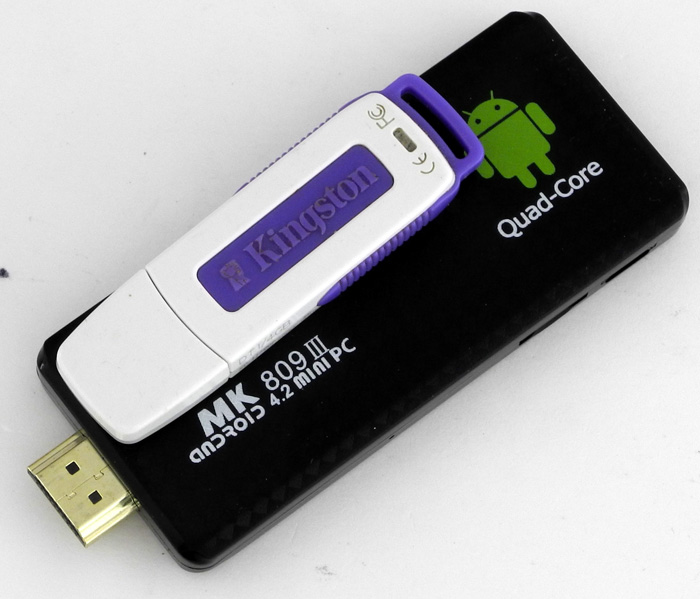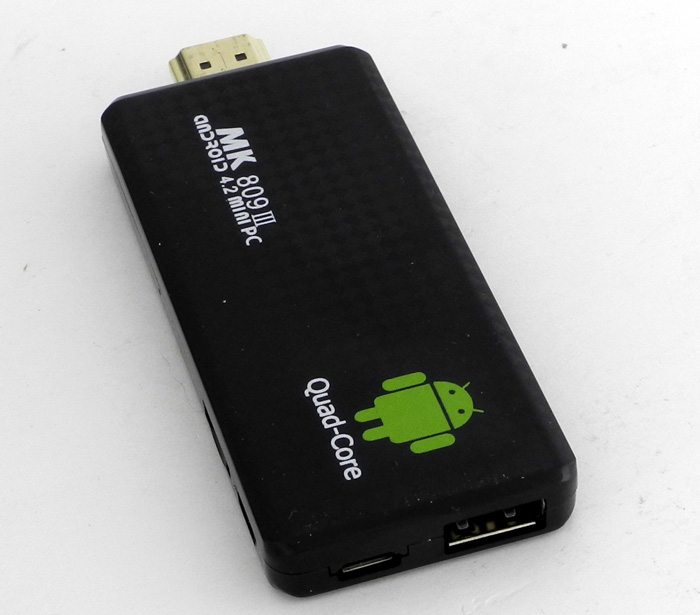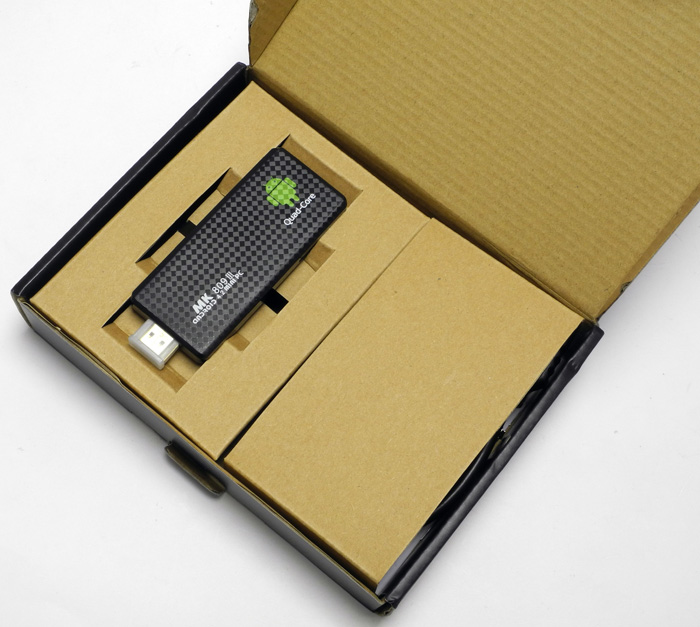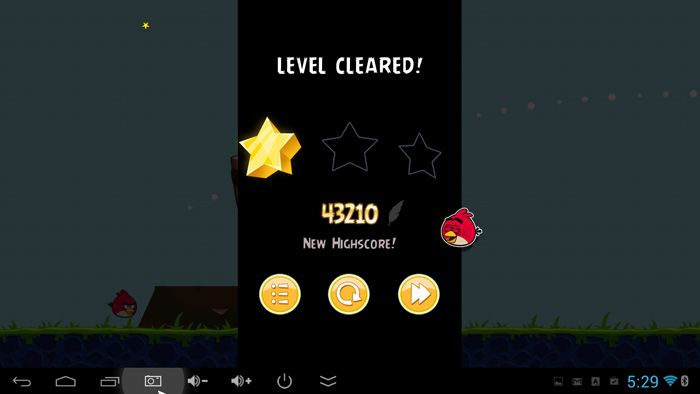MK 809III Android Mini PC: a computer in your pocket
Android OS confidently captured the market of smartphones and tablets, next in line are ATMs, teapots and toilets, car navigators, monoblocks, digital cameras, TVs. However, if you wish, you can get Android in a monitor / TV right now: recently, Chinese craftsmen have become skilled at producing mini-computers based on Android, which are slightly larger than USB sticks and are mainly oriented to work with a TV. On Amazon or Ali Express, such models are a wagon and a small trolley, and prices start at $ 30. Natural curiosity prevailed over the toad that lives in each of us, and I decided to order such a joke to test it. I’ll note right away that I have a LG47LM669S TV with fully sane firmware that can play many formats,
To check, so to check, so I chose the most advanced model, MK 809III - based on a quad-core processor and running Android 4.2. Judging by the offers of online stores, Rockchip processors are mainly used in such mini-PCs. In my case, this is Rockchip RK3188, cheaper options are equipped with a dual-core Rockchip RK3066 processor. By the way, observing such a “variety”, the conclusion suggests itself that all “USB-sticks” are clones of the reference mobile device developed by Rockchip itself.

However, quite a prelude, let's turn our eyes to the device itself.
I open the box and ... The first thought - and yet it is big! Indeed, comparing the MK 809III with a conventional flash drive (I'm not talking about media made using COB technology) is the same as comparing a glass and a decanter. MK 809III is about four times the size of a regular flash drive. Perhaps in a few years the dimensions of such mini-computers will really be compared with the dimensions of flash drives, but so far we have what we have. However, this does not mean that the device should not be carried in your pocket. I just expected something ... less.


But the device has been assembled in good conscience: both halves of the case are simply perfectly fitted to each other. And the “checkered” finish was also pleasant: cheerful, tenacious, and besides, there are absolutely no fingerprints left. The back panel of the device has openings. Apparently, for cooling.


There are only four connectors on the case. The most important one is HDMI, through which the MK 809III "fits" with a monitor, TV or other display device. The other three sockets are USB (more precisely, one full-sized USB and two micro-USB). They are used to connect peripherals (mouse / keyboard) and drives. Next to one of the micro-USB is a microSD card slot.

The biggest ergonomic miscalculation of the device is the lack of a hardware power button (it’s easy to turn it off from the OS itself). The only button in the device is on its side and recessed into the case so that you can press it only with a paper clip (in the photo below it is circled in a red circle). The assignment of this key was never determined: the computer did not respond to pressures, whether single or continuous.

MK 809III comes in a rather large box where, in addition to the computer itself, you can find a USB-micro-USB wire and a power plug, an HDMI extension cable (useful if you have difficulty connecting the computer to the TV due to the tight layout of the connectors of the latter) and a micro- USB-USB for, for example, connecting a drive.


In the kit there is a very brief instruction, but there is absolutely no sense in it: half of the 22 pages is in Chinese, only part of the program functions is described, the screenshots are too dark to make out.

And one more thing: due to the fact that the instruction does not explain the design features of mini-PCs, the latter had to be studied using the scientific poke method. For example, power should be supplied through the micro-USB port located on the end of the case, and not on the side.

As mentioned above, the hardware base of the MK 809III is the SoC Rockchip RK3188, which is produced according to the 28-nanometer process technology and includes the quad-core ARM Cortex-A9 CPU and the quad-core Mali-400 MP GPU (533 MHz). The maximum processor frequency is 1.8 GHz, but in the case of MK 809III it is 1.6 GHz. I note that at the moment this platform is one of the most productive in the average price range.

What else is included in the MK 809III? 2 GB of RAM and 4 GB of internal flash memory, Wi-Fi and Bluetooth adapters.
Even when I looked at the characteristics of the mini-PC before the purchase, I had a feeling that the manufacturer (in this case, Rockchip itself) took and shoved a cut-off motherboard from a tablet with soldered peripherals into the MK 809III. This guess was confirmed when working with the device: every now and then Android asked "to do something with the tablet." For example, when you press the virtual shutdown button, the system asks a typical question - “Turn off the tablet or not?”.
shutdown
On the other hand, we can’t say that the developers did not carry out at least minimal adaptation of the software part due to the specifics of using mini-PCs.
MK 809III is running Android 4.2.2. There are no add-ons for the interface - the user gets naked Android with several pre-installed applications, the names of which speak for themselves: eHomeMediaCenter, Explorer, Apkinstaller. That's right: the device provides access to Google Play, where you can download everything you need.


I quickly got used to controlling the Android mouse, but the lack of a touch screen deprives many of the charms. For example, you can’t play games anymore. Although I still managed to pass one level of Angry Birds.

I drove the MK 809III in all popular benchmarks, even though the screenshots with the test results speak for themselves.




For comparison, in AnTuTu, my Nexus 7 on the NVIDIA Tegra 3 platform is barely gaining twelve and a half thousand parrots, and the result in Quadrant is 3380 points. So with performance, Rockchip RK3188 is more than good.
Here you should also talk about how well the MK 809III handles video files of various formats and resolutions. To do this, I installed two of the most common video players from Google Play - BS Player and MX Player. They are also installed on my tablet (although in 99% of the cases I get by with the free version of BS Player). In case the file could not be played by one player, I used another. The results are as follows: somewhere out of 60 files, it was not possible to view only one with a resolution of 3840 x 2160 pixels. All the rest, regardless of the codec, bit rate and resolution, were reproduced with a bang.
Surely many are concerned about the question of how compatible the MK 809III is with drives and peripherals. So - compatible perfectly. The device correctly recognized the three wired mice and the Logitech K520 radio kit. The latter is especially nice: I hung both the mouse and keyboard on one port, and the second remains free to connect drives.
Speaking of drives. MK 809III calmly recognized a 500 GB Apacer external hard drive with USB 2.0 interface, 1 TB external Silicon Power HDD with USB 3.0 interface and a whole bunch of flash drives of different sizes with USB 3.0 and USB 2.0 interfaces. In a word, there are no problems with connecting drives and peripherals - but for a device that can replace HTPC, this is crucial.
It seems to me that devices like the MK 809III are still too highly specialized. They are not able to replace the desktop computer, in addition, if you don’t have a touch screen at hand, you will not be able to feel all the charms of the Android OS. You don’t have to play evil birds, but drive in Real Racing.
So who can use such devices? It seems to me that the MK 809III is still a good alternative to HTPC, which is much more compact (in my case, the “flat box” is not even visible behind the TV) and powerful enough to play any movies from any media. A mini-PC can be useful for owners of "older" TVs, which have enough HDMI video inputs, but the firmware functionality is lame. As practice shows, such TVs are more than enough. The built-in media player in them is not omnivorous, and there can be problems with connecting drives. In this case, the MK 809III is a good option for expanding functionality, and also quite affordable.
Another category of people who may be interested in Android mini-PCs is vacationers. A mini-PC is not a heavy burden, but at the same time in a hotel or hotel it will allow you to easily watch an interesting movie on the TV in your room.
As for the MK 809III, I liked the device. It is quite functional and moderately compact, performance is completely excellent, and the price does not bite very well. And if I often went on vacation or at least owned an old TV, I would certainly actively use the device.
To check, so to check, so I chose the most advanced model, MK 809III - based on a quad-core processor and running Android 4.2. Judging by the offers of online stores, Rockchip processors are mainly used in such mini-PCs. In my case, this is Rockchip RK3188, cheaper options are equipped with a dual-core Rockchip RK3066 processor. By the way, observing such a “variety”, the conclusion suggests itself that all “USB-sticks” are clones of the reference mobile device developed by Rockchip itself.

However, quite a prelude, let's turn our eyes to the device itself.
Appearance
I open the box and ... The first thought - and yet it is big! Indeed, comparing the MK 809III with a conventional flash drive (I'm not talking about media made using COB technology) is the same as comparing a glass and a decanter. MK 809III is about four times the size of a regular flash drive. Perhaps in a few years the dimensions of such mini-computers will really be compared with the dimensions of flash drives, but so far we have what we have. However, this does not mean that the device should not be carried in your pocket. I just expected something ... less.


But the device has been assembled in good conscience: both halves of the case are simply perfectly fitted to each other. And the “checkered” finish was also pleasant: cheerful, tenacious, and besides, there are absolutely no fingerprints left. The back panel of the device has openings. Apparently, for cooling.


There are only four connectors on the case. The most important one is HDMI, through which the MK 809III "fits" with a monitor, TV or other display device. The other three sockets are USB (more precisely, one full-sized USB and two micro-USB). They are used to connect peripherals (mouse / keyboard) and drives. Next to one of the micro-USB is a microSD card slot.

The biggest ergonomic miscalculation of the device is the lack of a hardware power button (it’s easy to turn it off from the OS itself). The only button in the device is on its side and recessed into the case so that you can press it only with a paper clip (in the photo below it is circled in a red circle). The assignment of this key was never determined: the computer did not respond to pressures, whether single or continuous.

Completeness
MK 809III comes in a rather large box where, in addition to the computer itself, you can find a USB-micro-USB wire and a power plug, an HDMI extension cable (useful if you have difficulty connecting the computer to the TV due to the tight layout of the connectors of the latter) and a micro- USB-USB for, for example, connecting a drive.


In the kit there is a very brief instruction, but there is absolutely no sense in it: half of the 22 pages is in Chinese, only part of the program functions is described, the screenshots are too dark to make out.

And one more thing: due to the fact that the instruction does not explain the design features of mini-PCs, the latter had to be studied using the scientific poke method. For example, power should be supplied through the micro-USB port located on the end of the case, and not on the side.

Interior
As mentioned above, the hardware base of the MK 809III is the SoC Rockchip RK3188, which is produced according to the 28-nanometer process technology and includes the quad-core ARM Cortex-A9 CPU and the quad-core Mali-400 MP GPU (533 MHz). The maximum processor frequency is 1.8 GHz, but in the case of MK 809III it is 1.6 GHz. I note that at the moment this platform is one of the most productive in the average price range.

What else is included in the MK 809III? 2 GB of RAM and 4 GB of internal flash memory, Wi-Fi and Bluetooth adapters.
Even when I looked at the characteristics of the mini-PC before the purchase, I had a feeling that the manufacturer (in this case, Rockchip itself) took and shoved a cut-off motherboard from a tablet with soldered peripherals into the MK 809III. This guess was confirmed when working with the device: every now and then Android asked "to do something with the tablet." For example, when you press the virtual shutdown button, the system asks a typical question - “Turn off the tablet or not?”.
shutdown
On the other hand, we can’t say that the developers did not carry out at least minimal adaptation of the software part due to the specifics of using mini-PCs.
Programmability
MK 809III is running Android 4.2.2. There are no add-ons for the interface - the user gets naked Android with several pre-installed applications, the names of which speak for themselves: eHomeMediaCenter, Explorer, Apkinstaller. That's right: the device provides access to Google Play, where you can download everything you need.


I quickly got used to controlling the Android mouse, but the lack of a touch screen deprives many of the charms. For example, you can’t play games anymore. Although I still managed to pass one level of Angry Birds.

Performance
I drove the MK 809III in all popular benchmarks, even though the screenshots with the test results speak for themselves.




For comparison, in AnTuTu, my Nexus 7 on the NVIDIA Tegra 3 platform is barely gaining twelve and a half thousand parrots, and the result in Quadrant is 3380 points. So with performance, Rockchip RK3188 is more than good.
Here you should also talk about how well the MK 809III handles video files of various formats and resolutions. To do this, I installed two of the most common video players from Google Play - BS Player and MX Player. They are also installed on my tablet (although in 99% of the cases I get by with the free version of BS Player). In case the file could not be played by one player, I used another. The results are as follows: somewhere out of 60 files, it was not possible to view only one with a resolution of 3840 x 2160 pixels. All the rest, regardless of the codec, bit rate and resolution, were reproduced with a bang.
Compatibility
Surely many are concerned about the question of how compatible the MK 809III is with drives and peripherals. So - compatible perfectly. The device correctly recognized the three wired mice and the Logitech K520 radio kit. The latter is especially nice: I hung both the mouse and keyboard on one port, and the second remains free to connect drives.
Speaking of drives. MK 809III calmly recognized a 500 GB Apacer external hard drive with USB 2.0 interface, 1 TB external Silicon Power HDD with USB 3.0 interface and a whole bunch of flash drives of different sizes with USB 3.0 and USB 2.0 interfaces. In a word, there are no problems with connecting drives and peripherals - but for a device that can replace HTPC, this is crucial.
Urgency
It seems to me that devices like the MK 809III are still too highly specialized. They are not able to replace the desktop computer, in addition, if you don’t have a touch screen at hand, you will not be able to feel all the charms of the Android OS. You don’t have to play evil birds, but drive in Real Racing.
So who can use such devices? It seems to me that the MK 809III is still a good alternative to HTPC, which is much more compact (in my case, the “flat box” is not even visible behind the TV) and powerful enough to play any movies from any media. A mini-PC can be useful for owners of "older" TVs, which have enough HDMI video inputs, but the firmware functionality is lame. As practice shows, such TVs are more than enough. The built-in media player in them is not omnivorous, and there can be problems with connecting drives. In this case, the MK 809III is a good option for expanding functionality, and also quite affordable.
Another category of people who may be interested in Android mini-PCs is vacationers. A mini-PC is not a heavy burden, but at the same time in a hotel or hotel it will allow you to easily watch an interesting movie on the TV in your room.
As for the MK 809III, I liked the device. It is quite functional and moderately compact, performance is completely excellent, and the price does not bite very well. And if I often went on vacation or at least owned an old TV, I would certainly actively use the device.
